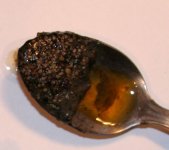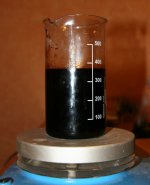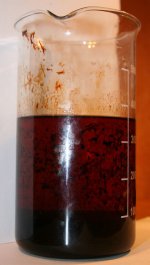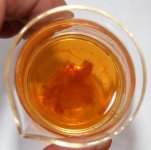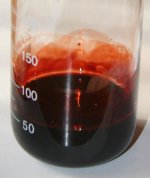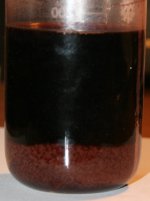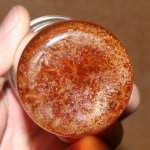Nobody seems to notice questions posed in the SWIM's other topic so she decided to start a new one.
SWIM ran his continuous solid-liquid extractor for 5 hours and collected 250 ml of dark purple IPA
Before the extraction she added phos acid to the IPA until the pH fell just below 3. After the extraction she decided to basify the IPA with lye. She added a teaspoon to the solution and soon noticed a thick black tar-like precipitate forming at the glass bottom.
She stirred it with an SS spoon and noticed that there are lots of small dirty-white chrystals embedded in the black tar (see pic.1). Her guess is that those were chrystals of lye that would not dissolve in IPA. Testing the solution pH confirmed her theory. It was just above 3. So she proceeded to dissolve a few teaspoons of lye in 50 ml of water and add it to the solution.
There was a reaction in the solution and soon it started to separate into 3 layers. Upper layer was dirty green. Middle was white, looking like emulsion and the bottom one was black (pic 2). First they were more or less equal in thickness and later the bottom one got thinner and the middle one almost disappeared. Then SWIM decided to stir the solution and see what happens.
In a few minutes the whole solution became black and thick (pic 3). It was so thick that it could not be stirred with a stirrer, so 60 ml water were added. Seeing that the solution closely resembled basified solution from an A/B extraction SWIM added to it 25 ml of heptane. Only later she has found out that IPA is lighter than heptane and will not float.
So now she's got her solution separated into 2 layers (pic 4). The top one is clear tea color IPA. The bottom dark opaque one with heptane trapped somwhere down there. Black flakes are parts of the bottom layer that got stuck to the glass walls.
Are there any idea how to get the spice from this mess?
Is it possible?
SWIM ran his continuous solid-liquid extractor for 5 hours and collected 250 ml of dark purple IPA
Before the extraction she added phos acid to the IPA until the pH fell just below 3. After the extraction she decided to basify the IPA with lye. She added a teaspoon to the solution and soon noticed a thick black tar-like precipitate forming at the glass bottom.
She stirred it with an SS spoon and noticed that there are lots of small dirty-white chrystals embedded in the black tar (see pic.1). Her guess is that those were chrystals of lye that would not dissolve in IPA. Testing the solution pH confirmed her theory. It was just above 3. So she proceeded to dissolve a few teaspoons of lye in 50 ml of water and add it to the solution.
There was a reaction in the solution and soon it started to separate into 3 layers. Upper layer was dirty green. Middle was white, looking like emulsion and the bottom one was black (pic 2). First they were more or less equal in thickness and later the bottom one got thinner and the middle one almost disappeared. Then SWIM decided to stir the solution and see what happens.
In a few minutes the whole solution became black and thick (pic 3). It was so thick that it could not be stirred with a stirrer, so 60 ml water were added. Seeing that the solution closely resembled basified solution from an A/B extraction SWIM added to it 25 ml of heptane. Only later she has found out that IPA is lighter than heptane and will not float.
So now she's got her solution separated into 2 layers (pic 4). The top one is clear tea color IPA. The bottom dark opaque one with heptane trapped somwhere down there. Black flakes are parts of the bottom layer that got stuck to the glass walls.
Are there any idea how to get the spice from this mess?
Is it possible?

